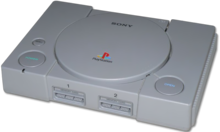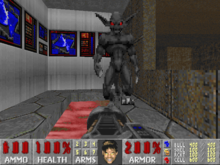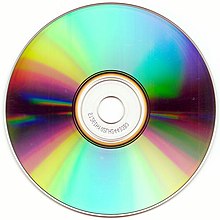Video Game History 1990–1999

The following is the most important data on computer and video game history from 1990 to 1999 .
Platforms
Arcade games
Even after their golden era and the video game Crash , influential arcade games continued to appear , especially beat 'em ups like Street Fighter II (1991) and Mortal Kombat (1992). More and more complex and realistic games and simulations appeared, as well as more and more large devices for four and more people, mostly racing games and shooters. At the end of the 1990s, board games such as: B. dance games and sports simulations, as well as games for which lightguns were used as control instruments.
Since 1985 arcade machines can only be found in amusement arcades in Germany due to a change in the law.
Consoles
The 5th generation began around 1993 and often offered new 3D graphics capabilities and sometimes CD-ROMs as data carriers. Many consoles had a 32-bit processor and / or 64-bit graphics capabilities. Real 64-bit devices appeared from 1996; 128-bit devices in Europe from 1999. Some game consoles released in the 1990s are:
- Sega Mega Drive (1990)
- Sony PlayStation (1994)
- Nintendo 64 (1996)
- Sega Dreamcast (1998)
The consoles Philips CD-i , PC Engine , Commodore CD³² , Atari Jaguar , Panasonic 3DO , Sega Saturn and Apple Pippin were also released .
Handheld consoles
- Game Boy (1990)
- Sega Game Gear (1990)
- Game Boy Color (1996)
Home computers
New home computers hardly appeared, the Commodore Amiga , which was produced until 1996, and the Atari ST , which was produced until 1993, were still particularly widespread .
Pc
The PC practically replaced the home computer. In the early 1990s, DOS games were still popular; In the middle of the decade, Windows games (for Windows 3.x and Windows 95) and games that required 3D graphics accelerator cards began to appear . The new graphics services were used in particular in first-person shooters , which also increased the use of online games.
Popular genres of the time
Ever higher processor and graphics capabilities made the first real first-person shooters possible from 1991 , a genre that is still very widespread today. Other popular genres were primarily survival horror and third-person shooters , role-playing games, strategy games, racing simulations, as well as board and music games .
Online games
Massive multiplayer online games (MMOGs) and in particular role-playing games ( MMORPGs ) for hundreds of players appeared around 1991, the big breakthrough came in 1997 with Ultima Online ; Browser games have existed since 1995. More and more conventional games have an optional online mode, e.g. B. Racing games. In addition, LAN parties where multiple computers are networked are becoming increasingly popular.
Important developers
Continuing the development of the 1980s, individual developers took a back seat, as practically all games were developed in medium-sized or larger teams. Well-known developers were:
- Ron Gilbert ( Monkey Island )
- Will Wright (game SimCity and others)
- Sid Meier (game Civilization and others)
- John Romero (Games Doom, Quake)
- Richard Garriott (Ultima Series)
- Jon Van Caneghem (Might & Magic series)
- Peter Molyneux (games Populous, Theme Park, Black & White and others)
Important companies
As before, Nintendo and Sega dominated the console market; In 1994 (1995 in Germany) Sony was added.
Big software publishers were Atari Corporation (later name owner Hasbro and Infogrames ), Konami , Electronic Arts , id Software and Blizzard Entertainment (from 1991), Ubisoft (from 1992), JoWooD (from 1995) and many others. There have been many takeovers; most of the smaller studios, especially those in the home computer market, quickly disappeared.
Data carrier / costs
1991 appeared with Sherlock Holmes: Consulting Detective, the first multimedia game on CD-ROM ; the price was 179 DM. This data carrier slowly gained acceptance until the mid-1990s; before that, mostly floppy disks were still sold. The prices were adjusted later and were still around 100 DM. In the case of older titles, the prices usually fell to around 30-50 DM, and there were also game collections. From 1990 the shareware principle became more and more popular, Commander Keen is an example .
Game consoles used different media, sometimes cartridges , but mostly also digital media such as CD-ROMs, and occasionally optical media such as GD-ROMs or laser discs. Console game prices varied between systems, but were often slightly higher than PC games and the games were not so easy to copy.
Chronicle / most important games of the decade
Important and successful games included:
- Wing Commander (1990, DOS-PC) space simulator
- Stunts (1990, DOS / Amiga) racing game 3D polygon graphics
- Street Fighter II (1991, initially as an arcade game) Fighting Game
- Mortal Kombat (1992, initially an arcade game) Fighting Game
- Wolfenstein 3D (1992, DOS) influential first person shooter
- Doom (1993, DOS) influential first person shooter
- Star Wars: Rebel Assault (1993, initially for IBM-PC / DOS) first computer game with full-motion video sequences (FMV)
- Tomb Raider (1996, initially for Sega Saturn) popular third-person shooter
- Resident Evil (1996, initially for PlayStation) influential survival horror
- Quake (1996, initially for DOS) 3D first person shooter
- Super Mario 64 (1996, initially for Nintendo 64) 3D platformer
- Pokémon Red, Blue, Green, and Yellow (1996, for the Game Boy ) collectible adventure
- Anno 1602 (1998, PC) popular building game and founder of the Anno series
- Half-Life (1998, initially for Windows PC) popular first-person shooter
- The Legend of Zelda: Ocarina of Time (1998, initially on Nintendo 64) action-adventure
- Tony Hawk's Skateboarding (1998) popular fun game
- Moorhuhn (1998) popular shooter
Other popular games included Civilization , Lemmings , Mario Kart , Alone in the Dark , Ultima Underworld (1992), Die Siedler , Myst , Age of Empires II (1999), Ridge Racer , X-Wing (1993), Command & Conquer , Donkey Kong Country (1994) and its successors, You Don't Know Jack (1995), Banjo-Kazooie (1998) and Donkey Kong 64 (1999).
Successful series and franchises:
- Final Fantasy series (from 1987 in Japan, 1990)
- Monkey Island (from 1990)
- Sonic the Hedgehog (from 1991)
- Tekken (from 1994)
- Pokémon (from 1996)
See also
- History of video games
- History of the game console
- List of game consoles
- Category: Computer game by year
literature
- Winnie Forster : Game consoles and home computers 1972-2005 . Gameplan, 2005, ISBN 3-00-015290-3 .
Web links
- Link catalog on the history of video games at curlie.org (formerly DMOZ )
- The history of video games: 1988 - 1993 on Cynamite.de
- The history of video games: 1993 - 1998 on Cynamite.de






